Last winter was long and hard. As a consequence, we burned about five cords of wood rather than our usual three-plus. I wrote last spring about some of the fun snow sport antics that required. I usually have two winter’s worth of wood on hand so everything gets about two summers’ worth of drying. With short summers, this ensures dry wood to burn (I usually work with 16-inch pieces and split it as we use it.)
Snaffling that extra couple of cords out of the coming winter’s wood made for an unusually long firewood season this year. We came out of last winter with about two cords on hand. We now have twelve. I bought four of those, meaning that I brought in six over the summer, about twice the usual level. Quite a bit of this came from generous neighbors who were happy to have recently felled trees taken away. But a bunch more came from the Boombah Haulage Company —wood hauled out of the nearby woods on my back.
Fresh wood is very heavy, generally over a ton per cord. Birch is a ton and a half. Usually, after I dice up a dead or recently fallen tree in the Boombah, I let it dry for a month or so on the ground before stacking it to dry further, then I haul it out one human-tolerable load at a time the following summer.
When we left off with the really distant piles that I got tired of sledding out last spring, I was sure it would be easier to haul them out by hand instead. I was wrong. It looks like I’ll finish that experiment this winter with the sled again. Note to self: Don’t cut wood that far away again.
In addition to providing cost savings, all of this is a massive carbon-footprint-lowering exercise. When we use firewood instead of fuel oil, we’re simply speeding up the release of carbon of dead wood instead of burning fossil fuels and releasing long-term trapped carbon into the atmosphere. A cord of dry firewood produces as much heat as over 100 gallons of fuel oil. This varies by the type of wood, but the three we burn are spruce (equivalent to ~130 gallons), aspen (~120 gallons), and birch (~190 gallons). By this measure, we saved well over 600 gallons of fuel oil last year. That’s thousands of dollars and a lot less carbon than not burning wood would release. How much carbon? 6.7 tons of CO2. So we can heat and feel good about it in three ways: the heat itself, the cost savings, and the lowered carbon footprint. That’s a lot of winning. This doesn’t even count the exercise that it takes to cut and move thousands of pounds of wood each year. I usually move every piece three times or more. This last summer by my estimation I moved a total of about 30,000 lbs. of wood to the area by the wood shed. It kept me off the streets.
So, is it all a big win? It comes close to being so. But we have an emissions problem in the Fairbanks North Star Borough: poor air quality often develops during cold spells. When it’s calm and cold (think -20s and -30s), we get temperature inversions that trap all our exhaust near ground level. It’s colloquially called ice fog, but it’s exhaust and small particulate matter than is unhealthy. We can also get this sort of unhealthy air in summer due to forest and tundra fires, but those are deemed natural and we can’t effectively control our behavior in the short term to mitigate it. Our wood stove upgrade several years ago was part of the borough’s burning management plan.
We’re in the winning phase of the year right now, with a hot fire in the stove on a gorgeous winter’s day and with plenty of wood on hand. As I walk through the woods and see next summer’s hard haulage work stacked here and there like squirrel stashes—some seemingly rather far from their destination—I know it’s not all cheery blazes and cozy warmth. But that task has its own season and brings its own satisfaction. In the meantime, let’s toss another log on the fire.

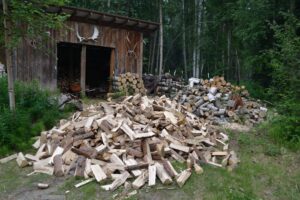
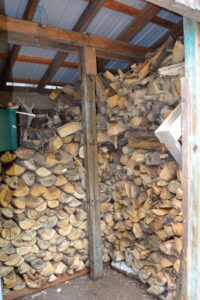
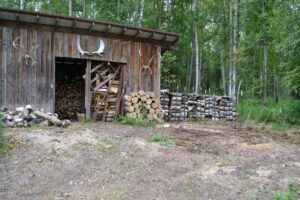
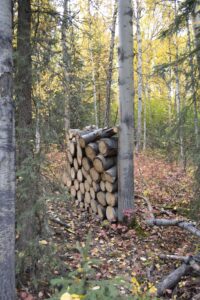
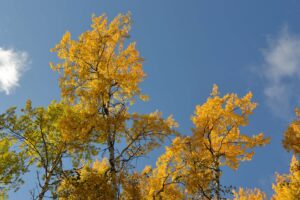
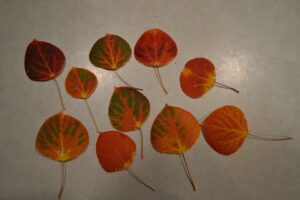
Wonderful story, Kevin.
I heated our place here in Jamestown mostly (abut 60%) with wood during our first ten years here – the rest with natural gas. That took about ten cords per winter – all cut from our back yard (locust and cherry) or from our place in the woods out of town (red maple, cherry, ash, hard maple).
I enjoyed the cutting, hauling, etc. for the most part, but have gotten less energetic in my dotage so I installed some more gas stoves which do most of the heating now – unless it gets down into single digits.
I built a stuga (little outhouse) for myself a couple of years ago where I can sit and work on my writing – it has electric, internet, and a wood stove. It’s a hectagon, 12′ in diameter so it doesn’t take much to make it comfy.
Thanks for sharing!
Please give my regards to Rose.
H, John. Great to hear from you. What an amazing amount of wood you’ve been dealing with — and of such qualities! I wish we had gas to augment our wood. It’s still not an economical option at our house (yet). Your stuga sounds like a great place for writing. I am eager to eventually get to see what you’ve been working on!
Best to you and Bonnie.
Thanks, Kevin. This book is actually all the stories that they made me take out from the Johns Hopkins book. Texas A&M is doing it, and it’s just about ready for the copy editor. You, of course, are a major player in it.
I am also working on a civil war novel, a novel based on my own war experiences, and a memoir of my Burma years. No publishers for any of those at present and there may never be, but I enjoy the process – especially in the stuga surrounded by my wildlife dependents – deer, skunk, raccoons, red and gray squirrels, chipmunks, and about 15 species of birds.
You are right about the wood. It is potentially high quality stuff. However because of my lack of planning, it never really gets a chance to dry properly. In fact a lot of it gets thrown in the fire a month or two after being cut – or at least it did when I was using 10 cords a winter. Now that I am down to a couple of cords, it gets a little more drying time.
Plenty in the woodshed, but nothing nasty yet.
Stay warm!
My best to you and Rose,
John
Good for you for pushing on past what editors and publishers say they want! Can’t wait to read ’em all!
I hear you on lack of planning and having wet wood. Fortunately, our heated garage allows me to recover from that when needed.
Best, K.
It kept you off the streets! It did you see something nasty in the woodshed?! 😉
Not yet, but I keep hoping.